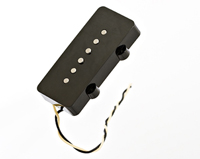Part 2 — Idiosyncrasies, Overall Design, and Helpful Mods
People often comment about the overall brightness of Jazzmasters. The treble quality can have an aggressive, biting tone, but it’s due to the idiosyncrasies of the guitar design… not just the pickups. Some of the brightness is due to loss of the “body” of the tone (and sustain) because of the bridge design. Possibly part of the delegation of the Jazzmaster to surf music is its lack of sustain compared to a Strat or Tele. Tonal “body” and sustain are directly related to the bridge having a low angle of string break which robs sustain and fullness of tone. You either have to run very heavy string gauges, or change the geometry of the bridge and neck angle by shimming more angle into the neck and raising the bridge up to increase the angle of the string over the bridge to the tailpiece. The extra break angle exerts more downward force onto the bridge and helps maintain a solid connection between the strings and the bridge saddles. You can also use a lighter gauge string if you increase the downward force… otherwise a low angle of string break would cause the strings to pop out of the saddles if you get aggressive with the pick.
Another mod you can do (that is completely reversible) is to add a part called a buzz stop. This is a roller you attach between the bridge and the tailpiece that further increases the string break angle. I use one and highly recommend it if you play hard and use strings lighter than .012, or bend strings quite often.
One more idiosyncrasy with the Jazzmaster… the string ground on the early Jazzmasters and possibly others is poorly executed. The bridge fits loosely into a couple of ferrules which the ground wire is attached to. This is the same case in the telecaster model that came with the factory installed Bigsby. When the whammy is used, contact with the ground wire can be broken and the guitar can become noisy. A fix for this problem is to move the ground wire to the whammy bar / tailpiece combination.
Noise levels on a Jazzmaster are higher than on a Strat pickup due to its larger surface area. You can expect more 60 cycle hum than a typical Fender (more of a P90 level hum), but Jazzmasters were always RWRP sets, which reduced the hum when the pickups were used together.
Next week’s blog will discuss Jazzmaster switching, and getting optimal tone.
In the meantime, learn more about Lollar Jazzmaster Pickups on our web site.
